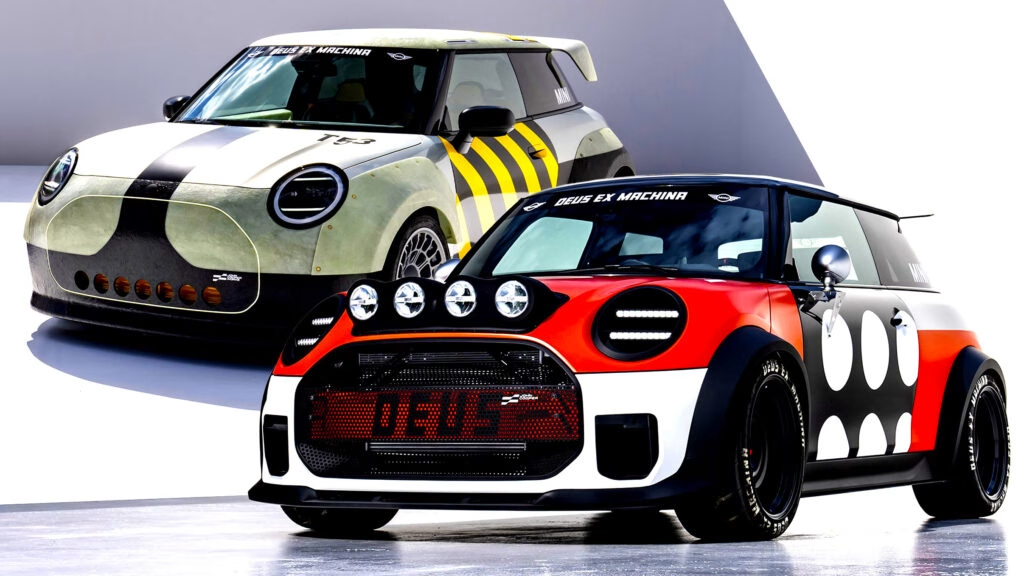What Makes the Mini x Deus Ex Machina Collaboration Stand Out?
When Mini teams up with a creative powerhouse like Deus Ex Machina, you know the results won’t be ordinary. This partnership has produced two one-off John Cooper Works (JCW) hatchbacks—Machina and Skeg—that are anything but subtle. Each car is a rolling canvas, blending Mini’s motorsport heritage with Deus’s flair for bold, lifestyle-driven design. The Machina is all about track-inspired aggression, while the Skeg channels laid-back surf culture. The result? Pure magic. You’ll spot them a mile away, thanks to custom body kits, wild graphics, and interiors stripped down for maximum impact.
How Do Machina and Skeg Differ in Style and Purpose?
Let’s break it down. The Machina, powered by a classic internal combustion engine, wears its racing heart on its sleeve. Think wide fender flares, a Can-Am-style rear wing, and a livery that screams speed—red, white, and black, with retro touches like hood-mounted lights and a custom grille. Inside, it’s all business: racing buckets with five-point harnesses, an exposed roll cage, and a hydraulic handbrake. Even the toggle switches are designed for quick access, ditching the usual touchscreen fuss.
On the flip side, the Skeg is a love letter to surf culture and electric innovation. Its silver, black, and yellow graphics are paired with raw, translucent fiberglass panels—a nod to surfboard craftsmanship. The closed grille glows, and the fender extensions aren’t just for show; they’re 15 percent lighter, thanks to the fiberglass construction. The pièce de résistance? A “Flex Tip Surf Spoiler” and a real surfboard strapped to the roof. Inside, you’ll find neoprene-trimmed racing seats, fiberglass trays for wetsuits, and straps instead of door handles. It’s a beach day, reimagined for the EV era.
Are These Just Show Cars, or Is There Real Performance Underneath?
Here’s where things get interesting. Despite their wild looks, both cars stick with standard JCW running gear. The Machina packs a 2.0-liter turbocharged four-cylinder engine, delivering 228 horsepower and 380 Nm of torque. The Skeg, being all-electric, offers a punchy 255 horsepower and 350 Nm of torque. Both sit on the tried-and-true John Cooper Works chassis, with no extra tuning under the hood. So, while you won’t find more speed, you will find a whole lot more personality.
What’s the Story Behind the Design Choices?
Mini and Deus didn’t just slap on some stickers and call it a day. Every detail is deliberate. The Machina’s oversized graphics and asymmetric wrap nod to Mini’s racing past, while the Skeg’s fiberglass panels and surfboard mount are a wink to Deus’s roots in surf and motorcycle culture. According to Mini’s design team, the goal was to create cars that are “rolling statements”—vehicles that turn heads and spark conversations, whether you’re at a track day or parked by the beach.
Will You Ever Be Able to Buy One of These?
Short answer: no. These are true one-offs, built to showcase what happens when two creative brands let loose. But there’s a silver lining. Mini and Deus are launching a limited apparel line inspired by the cars, debuting at the IAA Mobility Show in Munich. So, while you might not get your hands on the Machina or Skeg, you can still snag a piece of the collaboration—think jackets, tees, and accessories with the same bold attitude.
What Does This Collaboration Mean for the Future of Mini?
Collaborations like this are more than just marketing stunts. They’re a glimpse into how car brands are thinking about identity, customization, and lifestyle in a rapidly changing industry. With electric vehicles gaining ground and younger buyers craving authenticity, partnerships with lifestyle brands like Deus Ex Machina help automakers stay relevant and exciting. According to a 2023 McKinsey report, over 60 percent of Gen Z car buyers say brand personality and unique design are top priorities—Mini clearly got the memo.
The big takeaway? Automotive creativity isn’t about perfection—it’s about smarter adjustments. Start with one change this week, and you’ll likely spot the difference by month’s end. Whether it’s a bold new accessory or a fresh perspective on what your car says about you, sometimes it pays to color outside the lines.

